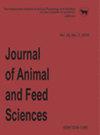Influence of fibrolytic enzymes mixture on performance, nutrient digestion, rumen fermentation and microbiota in Holstein bulls
IF 1.5
4区 农林科学
Q3 AGRICULTURE, DAIRY & ANIMAL SCIENCE
引用次数: 3
Abstract
Supplementation of fibrolytic enzymes (FE) into ruminant diets had been used as a nutritional strategy to improve performance via enhancing nutrient digestion (Beauchemin et al., 2004). It was previously demonstrated that supplementation with a mixture of xylanase and cellulase enhanced performance and nutrient digestibility in steers (Gómez-Vázquez et al., 2011) or cows (Yang et al., 2000). However, other researchers observed that average daily gain (ADG) and feed conversion ratio (FCR) were unchanged with supplementing xylanase and cellulase mixture (Krueger et al., 2008). The divergent responses should be related to the differences in activities and formulations of enzymes used in these studies. Eun et al. (2007) demonstrated that the optimum dose proportions and activities of supplied FE were critical for the magnitude of the improvement in forage utilization. The factors limiting the digestion of dietary fibre by rumen microbes were some plant cell wall ABSTRACT. The aim of the study was to evaluate the influences of fibrolytic enzymes mixture (FEM) – a mixture of cellulase, xylanase, pectinase and laccase – on nutrient digestion and ruminal fermentation in bulls. Eight Holstein bulls fitted with rumen cannula were used in a replicated 4 × 4 Latin square design and allocated to four treatment groups: control, low-FEM (LFEM), medium-FEM (MFEM) and high-FEM (HFEM) with 0, 0.25, 0.50 and 0.75 g/kg FEM, respectively. Even though the addition of FEM had a positive linear impact on dry matter (DM) intake and average daily gain, it had no influence on feed conversion ratio. Supplemented FEM linearly promoted nutrients total-tract digestibility, reaching greater values at 0.50 and 0.75 g FEM/kg DM. Rumen pH value and the ratio of acetate to propionate were reduced linearly, the concentration of total volatile fatty acids (VFA) elevated linearly but the content of ammonia-N was not influenced with increasing dose of FEM. For corn silage rumen degradation, effective degradability (ED) of DM and organic matter were quadratically reduced, reaching greater values in MFEM, whereas ED of neutral detergent fibre was linearly elevated. Supplemented FEM linearly increased activities of cellulolytic enzymes, α-amylase and protease and populations of bacteria, fungi, protozoa, Fibrobacter succinogenes, Ruminococcus albus, Prevotella ruminicola, Butyrivibrio fibrisolvens and Ruminobacter amylophilus, but had no impact on populations of methanogens and Ruminococcus flavefaciens. Supplemented FEM linearly increased urinary total purine derivative excretion. So, it was indicated that FEM enhanced nutrient digestibility and total VFA production, the optimum dose was 0.50 g/kg DM in bull diets. Received: 27 October 2021 Revised: 19 February 2022 Accepted: 7 March 2022纤维素酶混合物对荷斯坦公牛生产性能、养分消化、瘤胃发酵及微生物群的影响
反刍动物日粮中添加纤维分解酶(FE)已被用作一种营养策略,通过增强营养消化来提高性能(Beauchemin等人,2004)。先前已经证明,补充木聚糖酶和纤维素酶的混合物可以提高牛(Gómez-Vázquez等人,2011)或奶牛(Yang等人,2000)的性能和营养物质消化率。然而,其他研究人员观察到,补充木聚糖酶和纤维素酶混合物后,平均日增重(ADG)和饲料转化率(FCR)没有变化(Krueger等人,2008)。不同的反应应该与这些研究中使用的酶的活性和配方的差异有关。Eun等人(2007)证明,所提供的FE的最佳剂量比例和活性对饲料利用率的提高至关重要。限制瘤胃微生物消化膳食纤维的因素是一些植物细胞壁。本研究的目的是评估纤维分解酶混合物(FEM)——纤维素酶、木聚糖酶、果胶酶和漆酶的混合物——对公牛营养消化和瘤胃发酵的影响。8头装有瘤胃插管的荷斯坦公牛采用4×4拉丁正方形设计,分为四个处理组:对照组、低FEM(LFEM)组、中等FEM(MFEM)组和高FEM(HFEM)组,FEM分别为0、0.25、0.50和0.75g/kg。尽管FEM的加入对干物质(DM)的摄入量和平均日增重有正的线性影响,但对饲料转化率没有影响。添加FEM可线性提高养分的消化率,在0.50和0.75g FEM/kg DM时达到更高的值。瘤胃pH值和乙酸盐与丙酸盐的比例呈线性降低,总挥发性脂肪酸(VFA)浓度呈线性升高,但氨态氮含量不受FEM剂量增加的影响。对于玉米青贮瘤胃降解,DM和有机物的有效降解性(ED)呈二次降低,在MFEM中达到更大的值,而中性洗涤纤维的有效降解率(ED)线性升高。添加FEM线性增加了纤维素分解酶、α-淀粉酶和蛋白酶的活性,以及细菌、真菌、原生动物、产琥珀纤维杆菌、白色瘤胃球菌、瘤胃普雷沃氏菌、纤维溶性丁酸弧菌和嗜淀粉瘤胃杆菌的种群,但对产甲烷菌和黄致瘤胃球菌的种群没有影响。补充FEM使尿总嘌呤衍生物排泄量线性增加。因此,FEM提高了公牛日粮的养分消化率和VFA总产量,最适剂量为0.50g/kg DM。接收日期:2021年10月27日修订日期:2022年2月19日接受日期:2022月7日
本文章由计算机程序翻译,如有差异,请以英文原文为准。
求助全文
约1分钟内获得全文
求助全文
来源期刊

Journal of Animal and Feed Sciences
农林科学-奶制品与动物科学
CiteScore
2.10
自引率
0.00%
发文量
42
审稿时长
3 months
期刊介绍:
Journal of Animal and Feed Sciences (JAFS, J. Anim. Feed Sci.) has been published by the Kielanowski Institute of Animal Physiology and Nutrition, Polish Academy of Sciences in Jabłonna (Poland) since 1991. It is a continuation of the Polish-language journal Roczniki Nauk Rolniczych. Seria B, Zootechniczna published by the Polish Academy of Sciences since 1969.
JAFS is an international scientific journal published quarterly, about 40 papers per year including original papers, short communications and occasionally reviews. All papers are peer-reviewed and related to basic and applied researches in the field of animal breeding and genetics, physiology of nutrition, animal feeding, feed technology and food preservation. The journal distinguishes the multidisciplinary nature of physiological and nutritional sciences and so includes papers specialized in all fields connected with animal well-being, including molecular and cell biology and the emerging area of genetics.
 求助内容:
求助内容: 应助结果提醒方式:
应助结果提醒方式:


